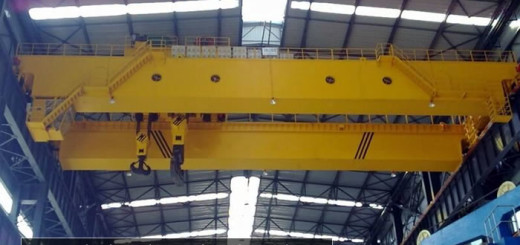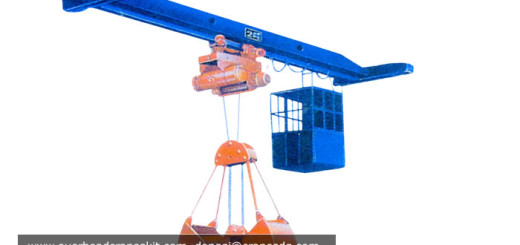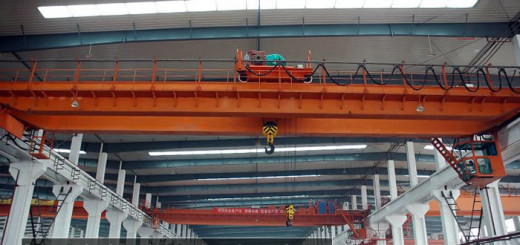Maintenance and construction method of electric single-beam bridge crane
Because the electric single-girder bridge crane is a special equipment, it needs to be carried out by a unit with a permit during maintenance, and the construction is carried out by a construction worker with a job certificate. During the construction process, all relevant safety operation regulations must be strictly observed and safety management must be strengthened. The editor introduces the maintenance methods of the main beam, end beam, electrical appliances, transmission part, electric hoist and other parts of the electric single-beam bridge crane.
Construction methods of main parts of the project:
- Main beam part: Check that the camber of the main beam should be (1/100-1.4/1000). The maximum camber should be located in the middle of the span, within the range of S/10. If the inspection result is out of the range, the flame correction method should be applied to reach the normal range.
- End beam part: the diagonal difference (E1-E2) measured with the reference point of the wheel ≤ 5mm. If the measured result exceeds the above range, the connecting bolts of the main beam and the end beam should be loosened, adjusted to meet the above standards, and the bolts should be tightened.
- Steel wire rope maintenance: Check the steel wire rope used for lifting. If there are broken strands or wear, reinforce or replace it according to the situation.
- Mechanical transmission part: refer to the manual to remove the reducer, open the cover of the reducer in order, and check the internal parts. If there is any replacement, remove them in order and replace them with new ones, then install them in the opposite direction of the removal, tighten the fixing bolts, and add oil.
Check the wheel: refer to the manual to remove the wheel to check whether the bearing is damaged, whether the wheel is cracked, and whether the wear program exceeds the normal use range. If you need to replace a new part, install it in the opposite direction after disassembly, and tighten the bolts. - Electrical part: check whether the cable is exposed or aging. If you need to replace it with a new one, install it according to the original model and original position.
Check the electrical box: whether the movable part of the electrical equipment such as the protection switch is flexible.
If it is damaged, loose or stuck, it should be removed or replaced with a new one.
Check the insulation resistance of motors, electromagnets, and resistors. If it is less than 0.5mΩ, it should be dried. - Lifting part of electric hoist: unload the electric hoist on the ground or lifting platform with a chain hoist in the opposite direction of the installation method. Refer to the disassembly manual of the electric hoist to disassemble the electric hoist for cleaning, and check whether the parts are damaged or cracked. If it needs to be replaced, replace it as required. After installation, install it in the opposite direction of disassembly, and add oil to the gearbox. Use hoisting tools to install the electric hoist on the main beam in the opposite direction of disassembly.
- Tests such as the alarm signal of each installation device (safety interlock) should be correct, sensitive and reliable.
- The trial operation of the crane should include the inspection before operation. No-load test run, static load test run, and dynamic load test run. If the previous step is unqualified, the trial operation of the next step shall not be carried out.
- No-load trial operation of single beam bridge crane:
(1) Start the motors of each mechanism separately, and their operation is normal. There should be no track jams when the carts and small carts are running, each braking function is accurate, and the limit switch action is accurate and reliable.
(2) When the hook is placed at the bottom position, the number of loops of the steel wire rope of the reel shall not be less than the working loop (except the fixed loop).
(3) The crane is anti-collision, and the buffer device should work reliably. - Load trial operation of crane:
(1) The lifting part should move 3-5 times. When rising to the switch, the limit switch action should be accurate and reliable.
(2) The cart should run around 3-5 times. There should be no jamming, skipping, deviation, etc., and the limit switch action should be accurate and reliable. - Static load test of crane:
(1) The static load test of the crane should be carried out after the no-load trial operation.
(2) The crane should stop at the post of the factory building.
(3) Park the trolley at the mid-span of the bridge. Gradually increase the load and do the lifting test run until the stiffening fixed load, make the trolley go back and forth several times in the full stroke of the bridge, and there should be no abnormal phenomena in all parts. After unloading the bridge structure, there should be no abnormal phenomena.
(4) Lift a load of 1.25 times the rated lifting weight without impact. Lift to a height of 100-200mm from the ground and hang and stay for 10 minutes. Then unload the load, drive the trolley to the end, and inspect the metal structure of the crane bridge. There should be no defects such as cracks, weld cracks, paint peeling, and other damage or looseness that affect safety. - The dynamic load trial operation of each mechanism should be carried out on the full stroke, the lifting capacity should be 1.1 times the predetermined lifting capacity, and the cumulative lifting and running time should not be less than 1 hour. The actions of each mechanism should be sensitive, stable and reliable. The action of safety protection interlocking device and limit switch should be accurate and reliable.




